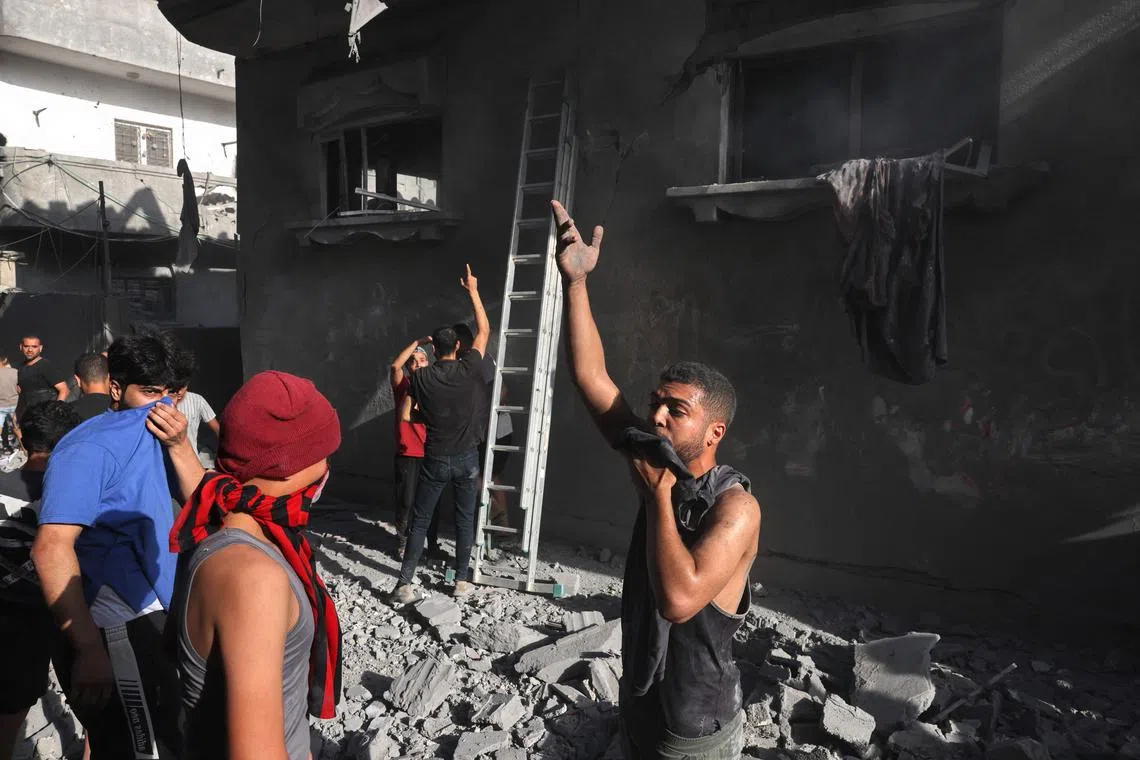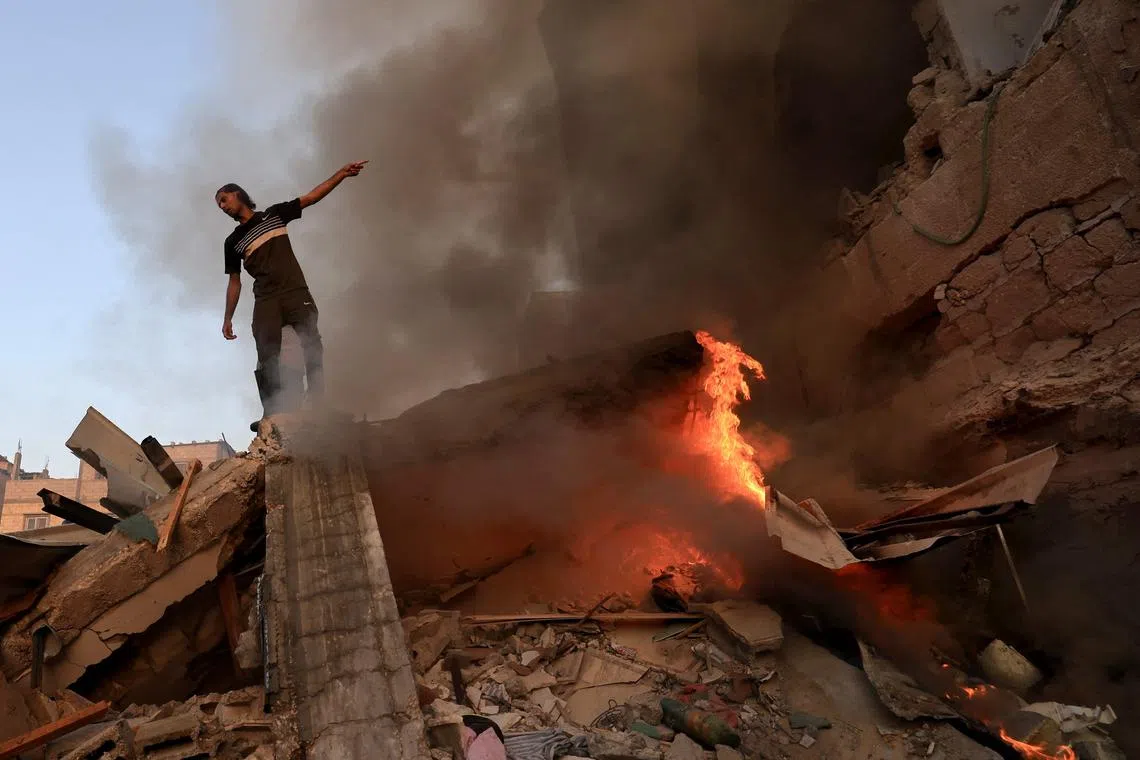Key moments in Israel's war with Hamas
Sign up now: Get ST's newsletters delivered to your inbox

Palestinians gather at the scene of a strike at the Nuseirat refugee camp in the central Gaza Strip on Nov 4.
PHOTO: AFP
Follow topic:
PARIS - War between Israel and Gaza’s Hamas rulers erupted after the Palestinian Islamist movement launched the worst attack in Israel’s 75-year history on Oct 7.
Israeli officials say more than 1,400 people, mainly civilians, were killed.
The Hamas-run health ministry in Gaza said Saturday that 9,488 Palestinians have been killed in Israeli bombardments, including 3,900 children.
Key developments:
Hamas carnage
At dawn on Oct 7, the sabbath and a Jewish holiday, rockets rain down on Israel from Gaza as hundreds of Hamas fighters infiltrate by land, sea and air into southern Israel.
More than 1,400 people, mainly civilians, were killed, according to Israeli officials.
They included 270 mainly young people at a music festival and hundreds more in communities near the Gaza border.
The militants took hostage of more than 240 people – Israelis and foreigners, officials said.
Israeli Prime Minister Benjamin Netanyahu spoke of “savagery not seen since the Shoah” – Hebrew for the Holocaust.
He vowed to “crush” Hamas, designated a “terrorist organisation” by the United States, Britain, Israel and the European Union.
Israel retaliates
Israel rapidly retaliated, pounding Gaza with air strikes as it battled Hamas fighters still inside Israel. It retook control of the Gaza border area on Oct 10.
Israel announced a “complete siege” on Oct 9,
On Oct 13, Israel urged northern Gaza’s citizens to move south within 24 hours. Hundreds of thousands of Palestinians flee.
The Arab League denounces a “forced transfer”.
Wider regional conflict?
Further north, Israel exchanged cross-border fire with Lebanon’s Hezbollah, a Hamas ally also backed by Iran.
In southern Lebanon, a Reuters video journalist is killed on Oct 13, and six journalists from AFP, Reuters and Al Jazeera are wounded in a strike.
Lebanon blames Israel.

A Palestinian man gestures as he stands on the rubble of a collapsed building as a fire burns following a strike by the Israeli military on Khan Yunis in the southern Gaza Strip on Nov 4.
PHOTO: AFP
Hospital strike
On Oct 17, a deadly strike hit Gaza’s Al-Ahli hospital.
The Hamas health ministry says at least 471 people were killed. US intelligence sources said “100 to 300“ people died.
Israel denied responsibility, blaming a misfired rocket by Islamic Jihad militants.
Thousands staged anti-Israel protests across the Arab world.
Five hostages freed
On Oct 20 and 22, four hostages, all women, were released. On Oct 30, an Israeli soldier, also a woman, was rescued in a ground operation by Israeli forces.
On Oct 28, Hamas said it is prepared to free hostages in return for Palestinian prisoners in Israeli jails.
First delivery of aid
The first humanitarian aid trucks entered via Gaza’s Rafah border crossing with Egypt on Oct 21.
Strikes intensify
On Oct 21, Israel intensifies its air strikes.
Iran warned the next day that the Middle East risks spiralling out of control.
Violations of humanitarian law
UN Secretary-General Antonio Guterres on Oct 24 denounced “the clear violations of international humanitarian law” in Gaza.
At least 1,400,000 Palestinians have fled their homes since the war began, the UN said.
Tanks into Gaza
On Oct 26 Israeli tanks enter Gaza for several hours.
The UN General Assembly called the next day for an “immediate humanitarian truce”.
International Criminal Court prosecutor Karim Khan on October 29 said preventing access to humanitarian aid could be “a crime”.
On Oct 27 the Israeli army said it has “expanded” its ground operations inside Gaza.
Mr Netanyahu announced “the second stage of the war” aimed at destroying Hamas’s military and leadership capabilities and rescuing the hostages.
A ceasefire “will not happen”, he said.
On Oct 31, Israeli forces reported “fierce battles” inside Gaza.
Evacuations to Egypt
On Nov 1 Egypt opened the Rafah crossing. Dozens of wounded Palestinians and hundreds of foreigners and dual nationals left Gaza.
Egypt said it will help evacuate “about 7,000“ foreigners and dual nationals.
Refugee camp bombed
Between Oct 31 and Nov 2 Israel’s military struck northern Gaza’s Jabalia refugee camp
Four UN schools sheltering displaced people were also hit.
UN-mandated human rights experts said “time is running out to prevent genocide and humanitarian catastrophe in Gaza”.
Gaza City surrounded
After almost a week of ground fighting in northern Gaza, Israel’s army announced on Nov 2 it had surrounded Gaza City.
On Nov 3, Israel began to send back thousands of Palestinian workers
In Tel Aviv, US Secretary of State Antony Blinken reiterated that Israel has the “right” and “obligation” to defend itself, but urged it to protect Palestinian civilians in Gaza.
He said Israel will only gain security through the creation of a Palestinian state.
Hezbollah warning
Hezbollah chief Hassan Nasrallah warned Israel against attacking Lebanon, saying “all options” are on the table, including “total war”.
Hamas said a deadly Israeli strike hit a convoy of ambulances near the territory’s largest hospital.
On Nov 4, Blinken reaffirmed US support for “humanitarian pauses” in the fighting, an idea Netanyahu has rejected.
Israeli chief of staff Lieutenant General Herzi Halevi visits troops on the ground inside Gaza. AFP

